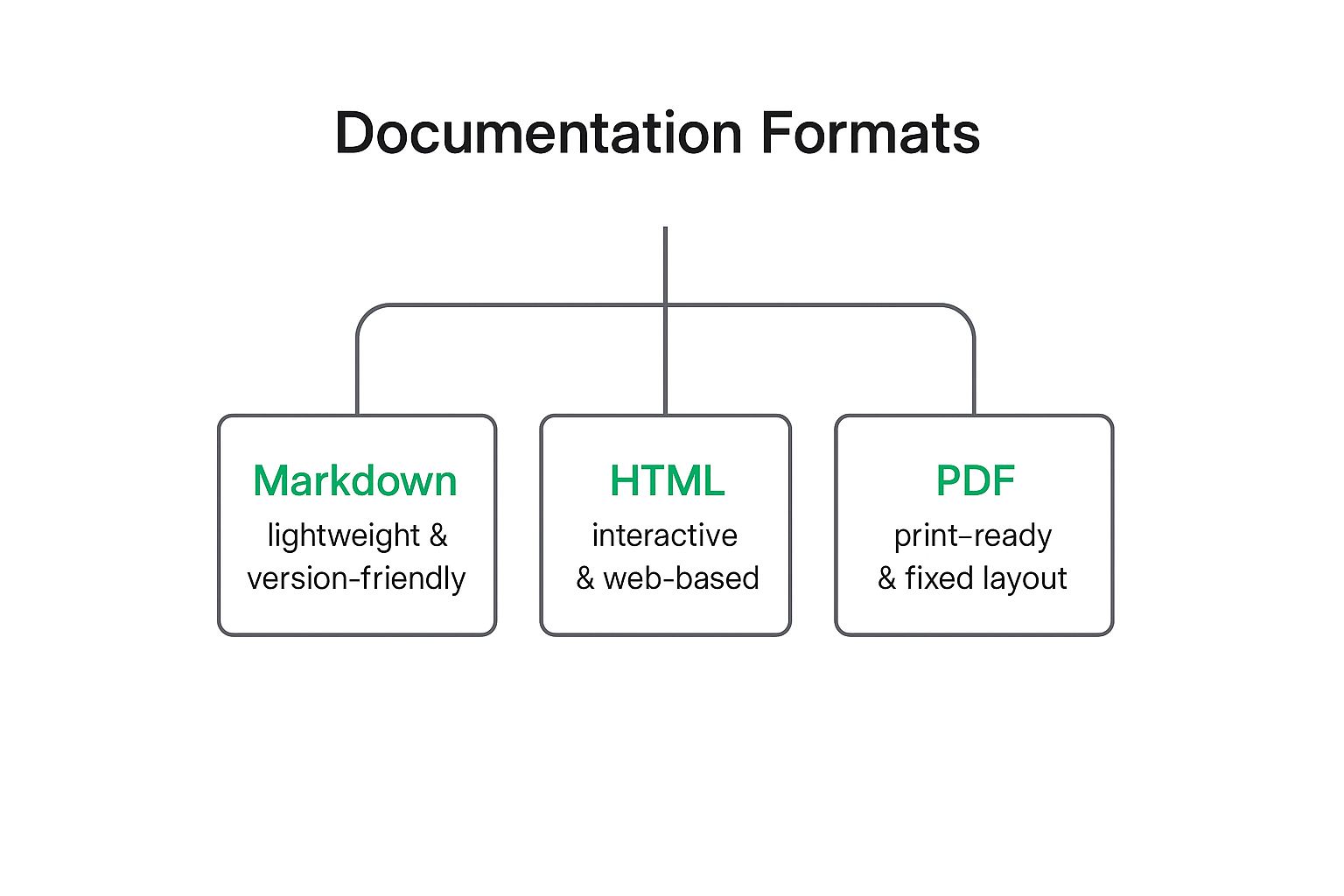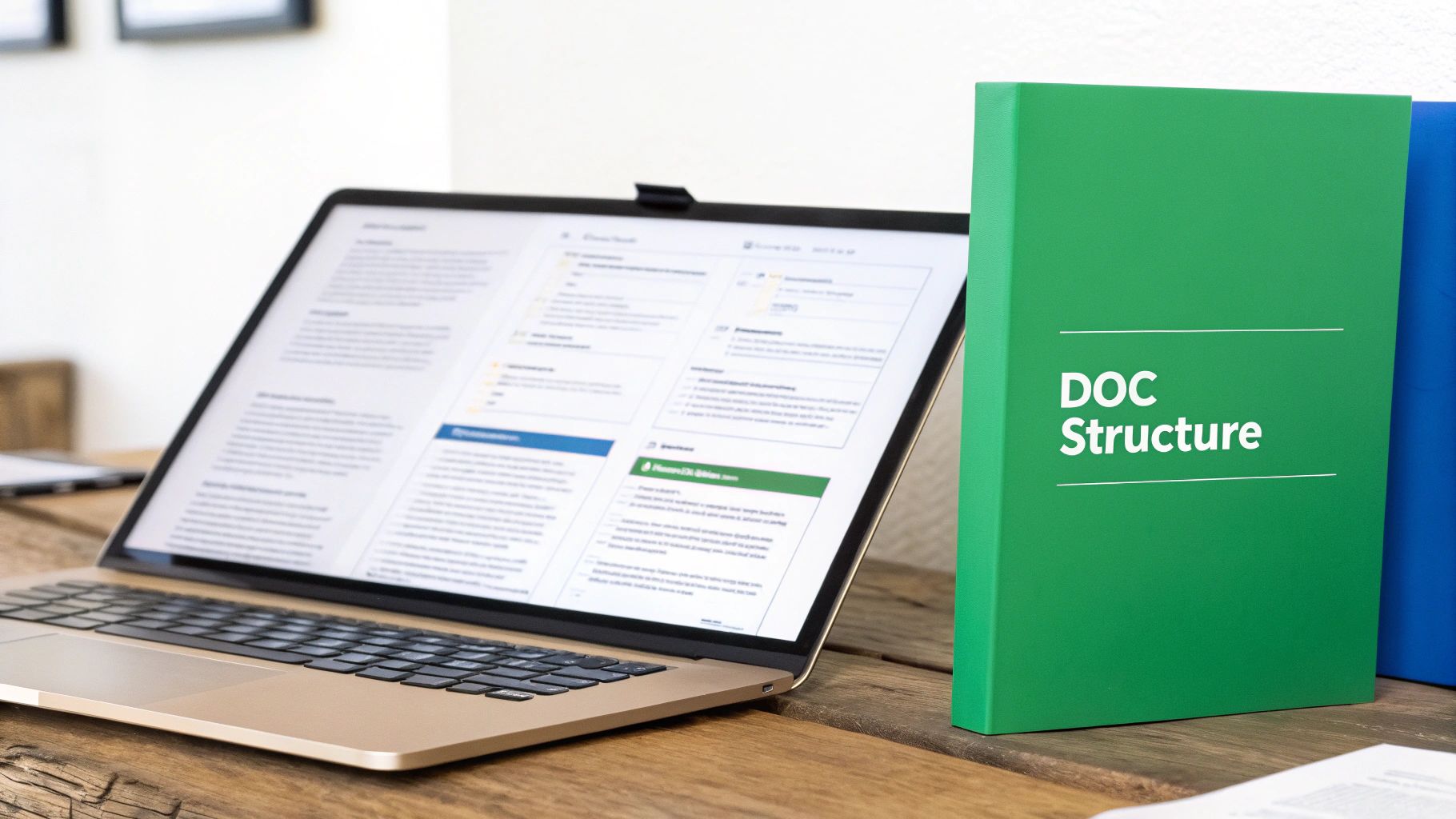Discover how to choose the right software documentation format. Our guide explains key formats, standards, and tools to help you create clear, effective docs.
A software documentation format is the blueprint for how you organize your technical content. It’s the agreed-upon structure everyone follows, from developers to end-users. This isn’t about picking fonts or colors; it’s a strategic choice about the underlying framework itself—like using Markdown for fast-paced developer guides or a structured HTML setup for polished user manuals.
Choosing the right format is one of the most important decisions you’ll make. It directly controls how easily your information can be written, updated, understood, and actually used by the people who need it.
Think of your documentation format like the architectural plans for a house. You wouldn’t just start building with a vague sketch. You need a detailed, universally understood blueprint to make sure the final structure is solid, safe, and works as intended.
In the same way, your documentation format provides a predictable structure that makes complex technical information easy to navigate. It creates a common ground for everyone involved, from the engineers deep in the code to the first-time user trying to learn your product.
This single decision echoes through the entire lifecycle of your project. A smart format choice makes your documentation more useful, simplifies maintenance, and helps your teams work together smoothly. For example, picking a format that plugs directly into your developers’ tools can make updating docs a natural part of their workflow, which is a huge win for keeping information from getting stale. On the other hand, a poor choice creates instant friction, slows down development, and can even stop users from adopting your product.
The best teams treat documentation as a core part of the project, not an afterthought. This means implementing software documentation best practices like defining the scope upfront, having a real content strategy, and enforcing a consistent style.
It’s no surprise that top-tier documentation teams often dedicate 10-20% of their total project time just to documentation. The payoff is huge—implementing a simple style guide can boost how fast users find information by up to 30%. That’s a massive productivity gain.
A well-chosen format delivers some serious benefits:
Getting this right isn’t just about writing things down. It’s about building a single source of truth that will support your software from its first line of code to its final version.
Choosing the right software documentation format isn’t just about picking a file extension. It’s about selecting the right tool for the job. Think of it like a mechanic’s toolbox—you wouldn’t grab a sledgehammer to tighten a tiny bolt. You need the right wrench.
In the same way, the format you choose determines everything: how information is written, where it’s stored, how it’s managed, and ultimately, how it’s used. A format that’s perfect for your internal developer notes might be a complete disaster for a customer-facing user guide.
The trick is to match the format’s strengths to your audience’s needs and your team’s workflow. Let’s break down the most common formats so you can see what they’re built for and where they truly shine.
To get a quick overview, this table compares the most popular documentation formats side-by-side. It’s designed to help you pinpoint the best option based on your specific needs, whether that’s ease of use, technical muscle, or the primary audience you’re writing for.
Now that you have a high-level view, let’s dive into the specifics of each category to understand their place in the documentation ecosystem.
For teams that practically live inside code editors and version control systems like Git, lightweight markup languages are king. They are designed for one thing: speed. Because they’re just plain text, they are incredibly easy for both people and machines to read.
These formats are the bread and butter for README files, API notes, and internal architecture docs—anything that needs to evolve right alongside the software itself. Their simplicity is their superpower.
When your documentation needs to reach a broader audience, especially non-technical users, you need a format built for presentation and interaction. This is where web-native formats step in, allowing you to create a rich and engaging experience.
This image shows the fundamental roles these formats play and how they cater to different priorities.

As you can see, there’s a clear trade-off. Markdown is built for version control, HTML is all about web interactivity, and PDF is designed for a static, printable layout.
Sometimes, documentation needs to be more than just instructions; it needs to be a contract. For highly technical and precise communication, especially between different systems, you need a format that defines rules and structures that both humans and machines can understand.
This is especially true for API documentation, where one wrong detail can break an integration.
By understanding these core categories—lightweight, web-native, and specification-driven—you can stop looking for a one-size-fits-all answer. The right software documentation format is really about building a versatile toolkit that serves every audience and every purpose effectively.

While picking the right software documentation format like Markdown or AsciiDoc is a big decision, there’s another layer to consider: industry standards. Think of these as the formal frameworks that enforce consistency and predictability, especially when the stakes are high in regulated or complex projects.
These standards aren’t meant to be rigid, creativity-killing rulebooks. Instead, they act as a shared language. It’s a lot like how the financial world relies on Generally Accepted Accounting Principles (GAAP). Just as GAAP ensures you can trust and compare financial statements from different companies, documentation standards make sure software plans from different teams are clear and complete. This shared understanding is absolutely vital for preventing costly mix-ups on large-scale projects.
Industry standards give you a blueprint for what to include and how to structure it. This simple act ensures that every critical part of a software design is actually thought through and recorded. It builds a bedrock of trust and predictability, which becomes non-negotiable when you’re dealing with audits, compliance, or massive projects spanning multiple organizations.
When everyone agrees on a standard, bringing new people onto the team gets a whole lot easier. Handoffs between departments become smoother. You’re not wasting precious time trying to figure out another team’s quirky, one-off documentation style. Instead, everyone can jump right into the technical details because the layout is familiar. This is what turns documentation from a messy collection of notes into a reliable, professional engineering asset.
One of the most influential standards shaping modern software documentation is IEEE 1016. This standard specifically governs how to create a Software Design Description (SDD)—the core document that explains how a software system will be built. Following IEEE 1016 means your documentation is no longer just a random assortment of files, but a structured, logical artifact that has real engineering value.
The IEEE 1016-2009 standard, for example, is very specific about what an SDD must contain. It calls for distinct sections like front matter (project titles, authors, version history), an introduction (project goals, glossary of terms), and of course, the detailed design descriptions. The insistence on maintaining a clear version table is especially critical for compliance auditors, who need to see a transparent and traceable history of every single change. To see how this works in practice, you can find a guide to software design documentation that breaks these requirements down.
This structured approach delivers some major wins:
So, how does this all circle back to your choice of a software documentation format? Well, trying to follow a comprehensive standard like IEEE 1016 is a lot easier when your format is built for structure. Markdown is fantastic for a quick README, but it will quickly start to feel inadequate when you need the rigid structure of a formal SDD.
This is exactly where more powerful formats come into their own.
Ultimately, picking a format that plays nicely with industry standards is a strategic decision. It doesn’t just make compliance a breeze; it sends a clear signal that you’re committed to professional, high-quality engineering—building trust with partners, regulators, and customers from the ground up.

Picking the right software documentation format goes way beyond a simple toss-up between Markdown and a PDF. It’s a strategic move that dictates how your information gets created, updated, and actually used. Think of it like choosing the right container for a job—you wouldn’t store water in a sieve or try to bottle air in a cardboard box. Each format is a container with its own strengths, built for a specific purpose.
The right choice will slot neatly into your project’s goals, your team’s workflow, and what your audience actually needs. Make the wrong call, and you’re just creating friction. That leads to stale docs, frustrated developers, and hopelessly confused users. To get it right, you need a clear-headed framework, which really just means asking the right questions to zero in on the best fit.
This is it. The big one. Answering this question is the most critical first step. What a developer needs is worlds apart from what a non-technical end-user or a system administrator requires. A format that’s perfect for one group can be completely useless for another.
Let’s say your main audience is developers. A lightweight format like Markdown is a fantastic choice, especially if you’re using a Docs-as-Code workflow in Git. But if you’re writing for end-users, a visually rich HTML-based knowledge base is infinitely better. And for those official compliance documents, sometimes a static PDF is still the necessary evil.
The complexity of your software has a direct impact on the features you’ll need from your documentation format. The docs for a simple mobile app look very different from those for a sprawling enterprise system with dozens of interacting microservices.
A basic project with one API might get by just fine with a well-written README file in Markdown. But as things get more complex, your documentation needs to scale up, too. You’ll need more advanced features to keep everything organized and prevent it from becoming a tangled mess.
Think about these factors:
If your project is on the complex side, a format like AsciiDoc gives you more firepower than Markdown, with built-in support for tables and file includes. For API docs, the OpenAPI Specification is practically a must-have, acting as a machine-readable contract that can generate interactive documentation automatically.
Your team doesn’t operate in a bubble. They have their favorite tools they use day in and day out, from code editors to CI/CD pipelines. Picking a software documentation format that plays nice with this ecosystem is a massive productivity boost. Trying to force a format that doesn’t fit is just asking for trouble.
If your developers live and breathe in Visual Studio Code, choosing a format with great plugin support like Markdown or AsciiDoc is a no-brainer. They can write and preview docs without ever having to switch contexts.
And don’t forget your deployment pipeline. If you’re using a static site generator like Docusaurus or MkDocs to build your documentation site, your format is pretty much decided for you—it’s almost always Markdown.
Documentation isn’t a “one and done” task; it’s a living asset. Its value plummets the second it becomes outdated. Because of this, your format choice has to consider the long game of updates and maintenance. Smart companies know that keeping documentation accessible is vital for future work, especially as the software itself changes.
Ask yourself these questions about the future:
For documentation that needs constant love, binary formats like .docx or PDF are terrible choices. They’re a nightmare to version control and require manual, clunky steps to publish. Text-based formats, on the other hand, are built for automation. They let you update, review, and deploy your docs in one smooth, continuous process, which is the key to keeping them from becoming stale and useless.

Choosing a software documentation format is just the first step. The real magic happens when you bring it to life, and for that, you need the right tools. Think of these tools as the workshop where your architectural blueprints—your chosen format—are transformed into a polished, genuinely useful asset.
Luckily, we’re spoiled for choice. Modern platforms can automate the tedious stuff, enforce consistency across your projects, and make the entire documentation lifecycle feel effortless. Whether you’re working with simple text files or building interactive web portals, there’s a tool out there that fits your team’s workflow and your audience’s needs.
Let’s dive into the main categories of tools that bridge the gap between a documentation plan and a finished product.
For teams embracing the Docs-as-Code philosophy, Static Site Generators (or SSGs) are non-negotiable. These tools take your simple, text-based files—like Markdown or AsciiDoc—and automatically spin them up into fast, beautiful, and searchable websites. The best part? It keeps your documentation living right alongside your source code.